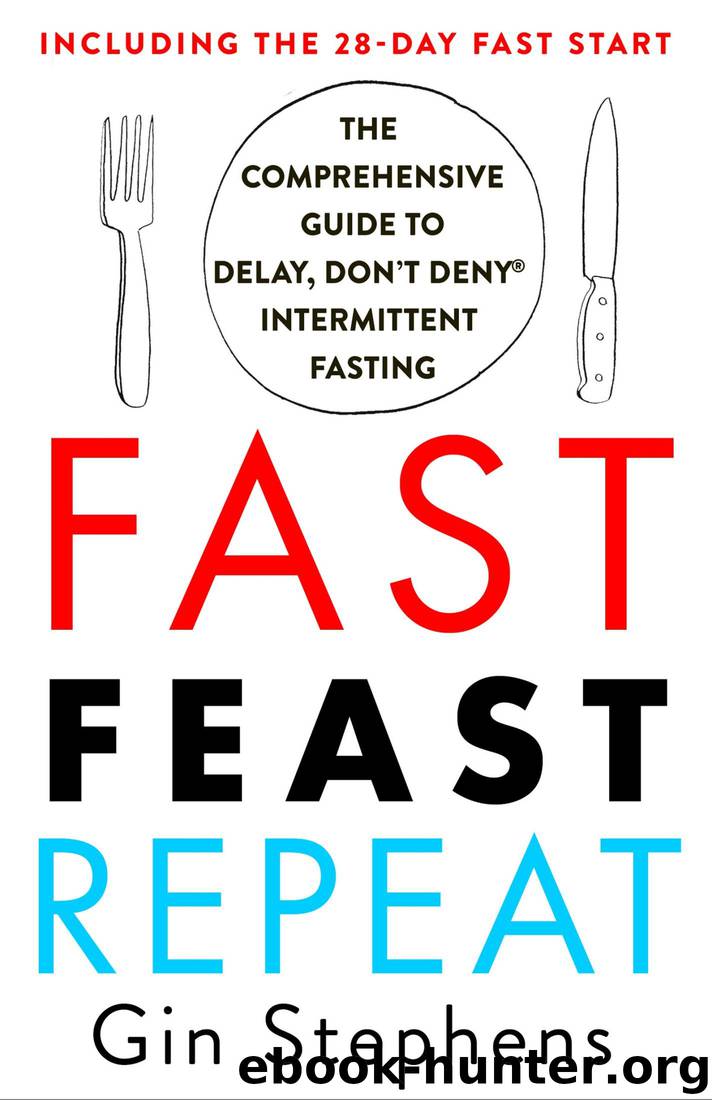Fast. Feast. Repeat. by Gin Stephens

Author:Gin Stephens
Language: eng
Format: mobi, epub
Publisher: St. Martin's Publishing Group
Published: 0101-01-01T00:00:00+00:00
As you can see, the bread that I make at home would fall into category 3: processed. I start with some items from category 1 (whole wheat, milk, yeast, and an egg), add in some items from category 2 (salt and honey), and end up with my homemade bread. In contrast, the bread I would buy at the grocery store in the bread aisle would fit into category 4: ultra-processed, with a long list of ingredients.
You can use the NOVA classification to help you make choices about what foods to emphasize. It’s simple—select mostly items from the first three categories, and limit items from the ultra-processed column.
You can also think of it this way: If we went back in time to before the Industrial Revolution and sat down with our great-great-great grandparents, what foods would have been available to them? Most of the foods that you eat on a day-to-day basis should be actual foods that they would recognize. Eat mostly those foods.
One of the problems with the foods from the ultra-processed column is that they have been designed to be hyperpalatable, meaning you “can’t eat just one.” (Remember that line from the popular commercial? They aren’t kidding!) These foods are also convenient, last a long time on the shelf, and are not only cheap for you to purchase but highly profitable for the food manufacturers.
When you eat a diet that is high in ultra-processed foods, you end up overfed and yet undernourished. In this instance, obesity is a form of malnutrition!5 I know that sounds counterintuitive; if someone is overweight, they have taken in too much food. That is true. But you can eat large quantities of ultra-processed foods and receive very few nutrients. Even though you may be carrying around dozens of extra pounds of fat, your body is literally starving for nutrition.
How does this happen? These ultra-processed foods drive you to eat more food.6 You see, our bodies don’t count calories; they count nutrients.
When you eat a diet that is made up of mostly ultra-processed foods, this is what happens. You eat. Your body realizes that you haven’t provided necessary nutrients and sends you a message: “That wasn’t it. Send something else down.” So, you eat again. “Nope. That still wasn’t it. Try again.” You eat something else. “Still no! Keep trying!”
Have you ever felt trapped in that type of vicious cycle? You’re eating and eating and yet not satisfied?
Now you are equipped to understand why that happens. If you eat and eat and aren’t satisfied, think about what you have eaten. Have you provided your body with sufficient nutrients? If not, now you know what to do! Send down some high-quality foods and see what your body thinks then.
For me, the difference is striking. I used to eat at McDonald’s frequently, and we had dinner from the drive-through at least once a week. Because I truly don’t demonize any foods (even now), I decided on a particularly rushed day that I would enjoy my favorite McDonald’s meal, guilt-free: a Big Mac and large fries, with a Coke.
Download
This site does not store any files on its server. We only index and link to content provided by other sites. Please contact the content providers to delete copyright contents if any and email us, we'll remove relevant links or contents immediately.
How to Be a Bawse: A Guide to Conquering Life by Lilly Singh(7430)
Deep Work by Cal Newport(6962)
The Longevity Diet by Valter Longo(5039)
The Fat Loss Plan by Joe Wicks(4874)
The Four-Pack Revolution by Chael Sonnen & Ryan Parsons(3945)
The Ultimate Bodybuilding Cookbook by Kendall Lou Schmidt(3906)
The French Women Don't Get Fat Cookbook by Mireille Guiliano(3629)
Super Food Family Classics by Jamie Oliver(3383)
Not a Diet Book by James Smith(3373)
Factfulness_Ten Reasons We're Wrong About the World_and Why Things Are Better Than You Think by Hans Rosling(3216)
Turn Up Your Fat Burn! by Alyssa Shaffer(3195)
Self-Esteem by Matthew McKay & Patrick Fanning(3115)
Tom Kerridge's Dopamine Diet: My low-carb, stay-happy way to lose weight by Kerridge Tom(3078)
Body Love by Kelly LeVeque(3029)
The Unbecoming of Mara Dyer by Michelle Hodkin(3018)
Tone Your Tummy Type by Denise Austin(2811)
The Fat Chance Cookbook by Robert H. Lustig(2810)
LL Cool J's Platinum 360 Diet and Lifestyle by LL Cool J(2707)
Men's Health Best by Men's Health Magazine(2570)
